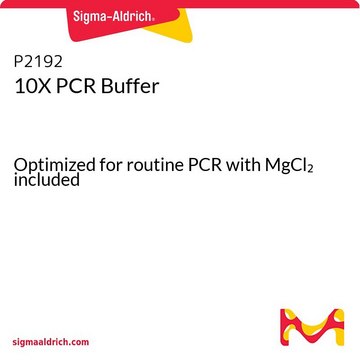MAK150
Fluorometric Intracellular pH Assay Kit
sufficient for 1000 fluorometric tests
Anmeldenzur Ansicht organisationsspezifischer und vertraglich vereinbarter Preise
Alle Fotos(2)
About This Item
UNSPSC-Code:
12161503
NACRES:
NA.84
Empfohlene Produkte
Verwendung
sufficient for 1000 fluorometric tests
Nachweisverfahren
fluorometric
Relevante Krankheit(en)
neurological disorders; genitourinary disorders; cancer
Lagertemp.
−20°C
Allgemeine Beschreibung
Intracellular pH changes are implicated in diverse physiological and pathological processes, including cell proliferation, apoptosis, fertilization, malignancy, multidrug resistance, ion transport, lysosomal storage disorders, and Alzheimer′s disease.
This kit can be utilized to measure decreases in intracellular pH in cells treated under various conditions using a simple standard protocol. Alternatively, an Acid-Load procedure can be used to measure the increase of intracellular pH associated with changes in cellular metabolism due to GPCR activation, growth factor activity, or other cellular stimulation. With the Acid-Load procedure ammonium chloride solution is added after the fluorescent pH dye is loaded into cells in a minimum volume. This Acid-Loading step is followed by the addition of agonist in a relatively large volume (~4x) of buffer. The sudden volume change initiates an efflux of ammonia (NH3) from the cells causing a rapid decrease in intracellular pH, and thus a decrease in fluorescence signal. The effect of agonist on the subsequent recovery of intracellular pH is measured by the relative fluorescence signal increase.
This kit can be utilized to measure decreases in intracellular pH in cells treated under various conditions using a simple standard protocol. Alternatively, an Acid-Load procedure can be used to measure the increase of intracellular pH associated with changes in cellular metabolism due to GPCR activation, growth factor activity, or other cellular stimulation. With the Acid-Load procedure ammonium chloride solution is added after the fluorescent pH dye is loaded into cells in a minimum volume. This Acid-Loading step is followed by the addition of agonist in a relatively large volume (~4x) of buffer. The sudden volume change initiates an efflux of ammonia (NH3) from the cells causing a rapid decrease in intracellular pH, and thus a decrease in fluorescence signal. The effect of agonist on the subsequent recovery of intracellular pH is measured by the relative fluorescence signal increase.
Anwendung
Fluorometric Intracellular pH Assay Kit has been used to measure the intracellular pH.
Leistungsmerkmale und Vorteile
Superior alternative to BCECF
Eignung
This kit can be utilized to measure changes in intracellular pH in cells treated under various conditions.
Prinzip
The Fluorometric Intracellular pH Assay Kit utilizes a proprietary cell-permeable fluorescent indicator, BCFL-AM, for measuring relative intracellular pH changes. BCFL-AM is a superior alternative to the popular ratiometric pH probe, 2′,7′-bis-(2-carboxyethyl)-5(6)-carboxyfluorescein (BCECF). Unlike BCECF, which is a complex and variable mixture of isomers, BCFL-AM is a single isomer species. BCFL-AM has the same spectral responses as BCECF-AM (λex = 490 nm/λem = 535 nm for single measurement or λex = 505 nm/λem = 535 nm and λex = 430 nm/λem = 535 nm for ratio measurement) but enhanced reproducibility. BCFL-AM exhibits pH-dependent dual excitability, pKa ~7.0, and an excitation isosbestic point of 454 nm.
Lagerklassenschlüssel
10 - Combustible liquids
WGK
WGK 3
Flammpunkt (°F)
Not applicable
Flammpunkt (°C)
Not applicable
Hier finden Sie alle aktuellen Versionen:
Analysenzertifikate (COA)
Lot/Batch Number
Die passende Version wird nicht angezeigt?
Wenn Sie eine bestimmte Version benötigen, können Sie anhand der Lot- oder Chargennummer nach einem spezifischen Zertifikat suchen.
Besitzen Sie dieses Produkt bereits?
In der Dokumentenbibliothek finden Sie die Dokumentation zu den Produkten, die Sie kürzlich erworben haben.
Kunden haben sich ebenfalls angesehen
Selective inhibition of carbonic anhydrase-IX by sulphonamide derivatives induces pH and reactive oxygen species-mediated apoptosis in cervical cancer HeLa cells.
Koyuncu I, et al.
Journal of Enzyme Inhibition and Medicinal Chemistry, 33(1), 1137-1149 (2018)
Shawn C Chafe et al.
Cancer immunology research, 7(7), 1064-1078 (2019-05-16)
Treatment strategies involving immune-checkpoint blockade (ICB) have significantly improved survival for a subset of patients across a broad spectrum of advanced solid cancers. Despite this, considerable room for improving response rates remains. The tumor microenvironment (TME) is a hurdle to
Unser Team von Wissenschaftlern verfügt über Erfahrung in allen Forschungsbereichen einschließlich Life Science, Materialwissenschaften, chemischer Synthese, Chromatographie, Analytik und vielen mehr..
Setzen Sie sich mit dem technischen Dienst in Verbindung.









